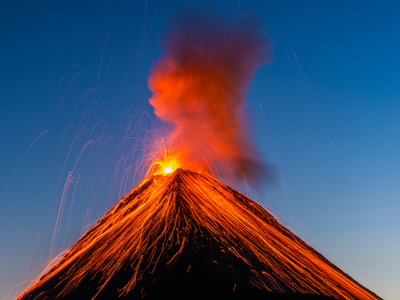
Grade 4 Reading Information - Information Integration
This English Language quiz is called 'Information Integration' and it has been written by teachers to help you if you are studying the subject at elementary school. Playing educational quizzes is an enjoyable way to learn if you are in the 3rd, 4th or 5th grade - aged 8 to 11.
It costs only $12.50 per month to play this quiz and over 3,500 others that help you with your school work. You can subscribe on the page at Join Us
Speaking fully about a topic requires students to research several sources. Usually, students can gather different facts from different sources even though they are about the same topic. The student must then be able to bring the facts together by categorizing them into their similarities. After that, they are ready to write or speak about the topic. In this quiz, students will analyze two sources about volcanoes and then answer questions about those sources.
Volcanoes erupt from the shifting of tectonic plates. One plate shifts and moves underneath another plate. When this happens, an earthquake, tsunami or other disaster may take place. Then water seeps into the plates. The rock surrounding the plates will melt at cooler temperatures. Then it comes into contact with other rock. Pressure forms as the rock or magma moves up to the surface and breaks through.
Another way that a volcano erupts is through rifting. This way begins with the crust flattening out. When the crust is flattening out, the pressure lowers. Again, similar to the first way, the rock melts at a cooler temperature. Then the magma of rock moves up through the volcanic mountain until it erupts.
There is one way that a volcano erupts without having lower temperatures and lower pressure. There are certain times when the rock underneath the surface gets very hot. In this case, it builds pressure and forces the hot magma through the volcanic mountain. These are known as hot spots.
Story 2 - Volcanoes
The majority of volcanoes are found in an area surrounding the Pacific Ocean. It is called the Pacific Ring of Fire. The tectonic plates and their location play a part in where volcanoes are and their eruptions.
Hawaii is known for having a large number of volcanoes. There are actually five active volcanoes in Hawaii which means they could erupt at any time. Volcanoes can erupt in one large lava flow or they can slightly spew out lava. The volcano Kilauea is still erupting after 25 years.
Probably the most famous volcanic eruption was in 1980 when Mount St. Helens erupted. This volcano is located in the state of Washington. The large volcanic eruption triggered many smaller earthquakes in the surrounding areas. Over 50 people died from the eruption and millions of dollars in damage was caused by this eruption.
What fact could you gather from this story?
What fact could you gather from this story?
What fact could you gather from this story?
What fact could you gather from this story?
What facts would you mostly find in this source?
What fact could you gather from this story?
What fact could you gather from this story?
What fact could you gather from this story?
What facts would you mostly find in this source?
What fact can be found in both texts?
Ready for more?
not all...
quizzers. Try to win a coveted spot on our Hall of Fame Page.







